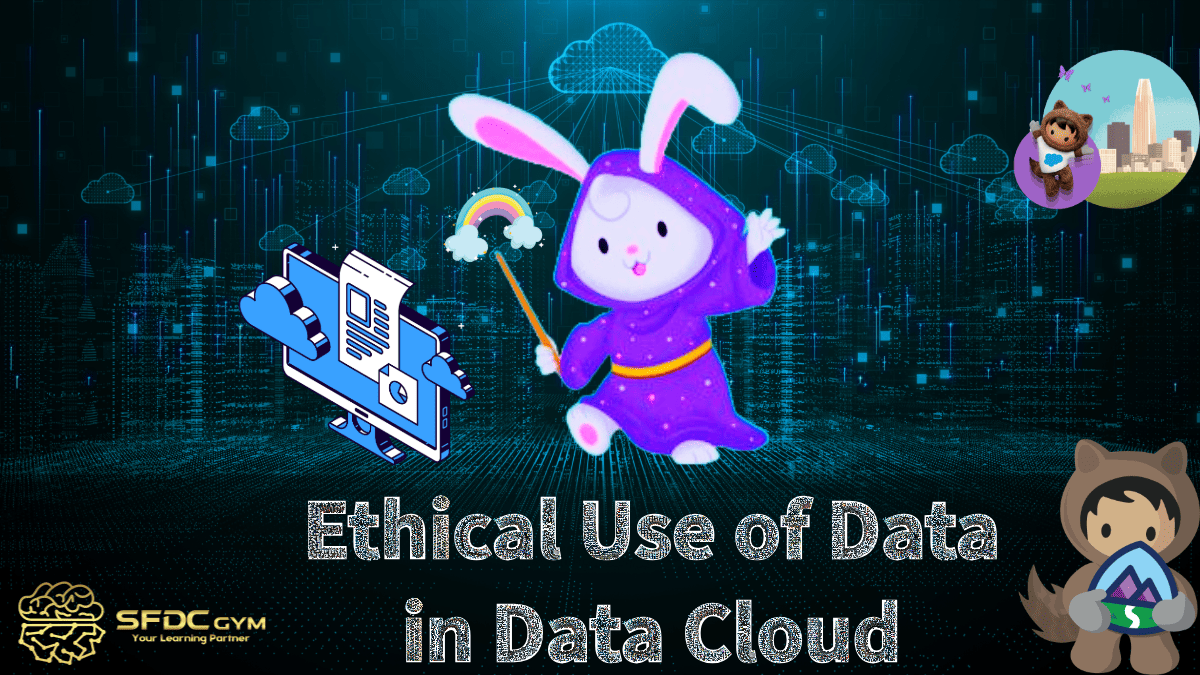Ethical Use of Data in Data Cloud



Ethical Use of Data & Cross-Channel Behavioral Messaging
Building Trust through Ethical Data Use
Data powers the digital world. For Data Cloud Architects, Salesforce Admins, and Data-Aware Specialists, managing this wealth of information requires more than just technical knowledge; it requires ethical responsibility. If data is the new currency, trust is the bank where it's stored.
This blog dives into ethical data use principles and cross-channel behavioral best practices to help architects and specialists design experiences that are impactful, compliant, and above all—trustworthy.
Understanding Ethical Data Use in Personalization
Customers expect personalization, but they also demand transparency, consent, and security. According to Salesforce research, 89% of customers are loyal to companies they trust, and 65% stop buying from brands they find distrustful. For Salesforce professionals designing and deploying personalization solutions, balancing innovation with ethics is key to fostering customer trust.
Key Risks in Personalization

- Data breaches: Poor security measures damage brand reputation.
- Unanticipated data usage: Consumers don’t expect their data to be used without their knowledge.
- Intrusive personalization: Over-stepping can lead to customer discomfort.
- Biased interactions: Demographic-based targeting risks perpetuating stereotypes.
Best Practices for Ethical Data Usage
- Be Transparent About Security: Customers need to trust that their data is safe. Share summaries of your security safeguards, like SOC Compliance or penetration test results.
- Obtain Explicit Consent: Collect data only when there’s a clear, stated purpose for its usage, such as improving CX or delivering relevant recommendations.
- Prioritize Behavioral Intent Over Pure Demographics: Target based on customer actions, preferences, or interactions instead of demographic categories that can introduce unintended bias.
Cross-Channel Behavioral Messaging and its Ethical Challenges
Cross-channel behavioral messaging occurs when interactions across various platforms (email, mobile, web) are unified to create consistent, connected experiences. While this approach appears customer-friendly, executing it ethically can be challenging.
Major Risks in Behavioral Messaging
- Over-personalization: Hyper-targeted messaging often feels invasive, undermining trust.
- Messaging Overload: Sending too many trigger-based communications frustrates recipients, deteriorating user experience.
- Implicit Bias: Behavioral targeting can unintentionally exclude or alienate certain groups.
For example, consider a "Price Drop Alert" for a product previously viewed. While ethical in intent, failing to clarify why the customer received it (“Based on your recent interest in X…”) can make it seem invasive.
Best Practices for Ethical Cross-Channel Behavioral Messaging
1. Collect and Respect Customer Preferences
- Obtain permissions at entry points and consistently honor them.
- Explicitly clarify the "why" behind messaging. Example copy could be, "You’re receiving this email because you explored products within [Category]."
2. Practice Audience-Centric Targeting
- Replace demographic-specific segmentation with interest-based targeting.
- Example Scenarios:
- Instead of targeting “men aged 25-35,” target “users whose behavior indicates interest in fitness tech.”
- Use inferred affinity rather than demographic categories to connect meaningfully.
3. Regulate Messaging Frequency
- Bombarding customers across web, mobile, and push notifications erodes brand experience. Implement frequency caps to limit repetitive communications while enhancing relevance.
- Example Action Plan:
- Consolidate all outbound communications into a unified calendar.
- Tailor message priority based on engagement history metrics.
4. Rely on Real-Time Data Responsibly
Traditional “batch-analyze” methodologies result in stagnant insights. Transition to real-time touchpoint monitoring, aligning customer experiences dynamically.
Example Use Cases:
- Real-time cart abandonment notifications.
- Quick responses to pricing triggers (like discounts).
Why Ethical Personalization Matters
By adhering to ethical personalization and cross-channel practices, companies don’t just retain compliance—they secure competitive advantages. Customer loyalty will outlast click metrics if it’s built on transparent, trustworthy interactions.
With Salesforce’s Marketing Cloud Personalization or Data Cloud architecture, every architect has all the practical building blocks needed. But remember, technology without integrity risks alienating the very customers it serves.
Take your ethical engagement practices to the next level—futureproof your sales funnel through customer-first architectural designs.


